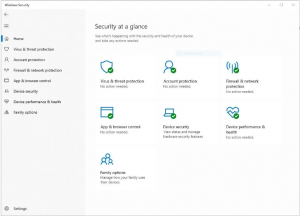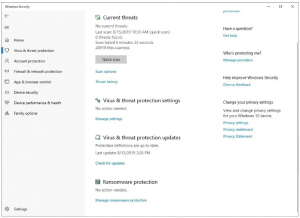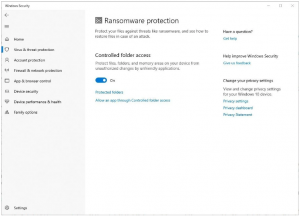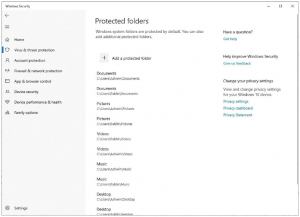Windows Defender incorporates a security feature called “Ransomware Insurance” that enables you to empower different assurances against ransomware contaminations. This element is crippled as a matter of course in Windows 10, however, with ransomware running widespread, it is critical to empower this component so as to get the most security you can for your PC.
On the off chance that you are an ordinary peruse of Bleeping Computer, at that point, you have caught wind of ransomware. For those inexperienced with the term, ransomware is a PC malware disease that encodes the information on your PC and afterward requests payment in bitcoins to unscramble them.
Windows 10 has the built-in function of ransomware protection. Here are the means by which to ensure you’re secured.
Ransomware is an especially awful kind of malware that not only denies access to your PC framework and information but requests a payoff be paid to open records.
What’s more, the measure of payoff requested props up. A multimillion-dollar request to an association isn’t unusual any longer
How would I get ransomware?
There are a few distinct ways that ransomware can infect(taint) your PC. One of the most generally perceived strategies today is through malicious spam, or Malspam, which is a spontaneous email that is utilized to convey malware. The email may incorporate booby-trapped connections or attachments, for instance, PDFs or Word documents(records). It might in like manner contain associations with noxious sites.
Malpas utilizes social engineering to trick individuals into opening connections or tapping on joins by showing up as genuine—regardless of whether that is by appearing to be from a confided-in association or org. and a companion. Programmers (Hackers) utilize social engineering (building) in different sorts of ransomware attacks, for instance, acting like the FBI in order to panic clients into paying them entire of cash to open their documents of different types, like audio-video text, etc.
Malvertising which arrived in the year 2016, or dangerous advertising or promoting, is the utilization or use of web-based publicizing to circulate malware practically without client or user collaboration required. While looking into the web, even genuine destinations, clients can be coordinated to criminal servers while never tapping on an advancement.
Window 10 Prevents You from Ransomware Virus
Microsoft offers worked in ransomware protection for Windows 10. Here’s the manner by which to make sure you’re protected. Ransomware is an especially horrendous type of malware that not only denies access to your computer system and information but demands a payoff be paid to open files. What’s more, the measure of payoff demanded keeps going up. A multimillion-dollar demand for an association isn’t uncommon anymore.
Windows Defender has been increasing a toehold steadily for as long as a few years. Yet, there is one blemish in the antivirus that boats with Windows 10.
The alternative for Ransomware Protection is disabled of course even though it is available as a native choice since the release of Windows 10 version 1709.
At first, I was bemused by this, yet then I thought it is possible that Windows Defender could identify a legitimate application as a threat and square it, which isn’t something the user would need.
Quite a few outsider enemies of ransomware projects exist and they do suffer from false positive issues also. Check out our reviews of App-Check Anti-Ransomware, Acronis Ransomware Protection, Trend-Micro Ransom Buster, or our overview of Anti-Ransomware software for Windows to get started.

For those unaware, ransomware is one of the deadliest types of malware. It silently encrypts your information or data (pictures, videos, and documents are ordinarily targeted), consequently preventing you from accessing them.
It might even bolt the bootloader when you reboot/turn off the computer. The malware shows a screen demanding payment from the user which generally involves a digital currency payment address that you have to send money to.
There is no guarantee that a payment will provide the open key required to regain access to files that the ransomware encrypted while it kept running on the system. Ransomware assaults are often accompanied by a timer to add another pressure layer to the ransomware demand. Affected users are asked to pay the sum in time as they won’t be able to decrypt their files anymore once the timer runs out. Decryption tools are available for some ransomware types however these are released after an outbreak generally and are not available right as it so happens.
Numerous companies, medical clinics, and users have injured individuals by ransomware. You may have heard of the frenzy caused worldwide by the WannaCry ransomware in 2017, and that is only one example of ransomware causing devastation worldwide. Besides being very careful when utilizing the computer, there are just a few choices to protect against ransomware assaults. Two of the best are reinforcements and security software that protects against ransomware.
How to enable Ransomware Protection in Windows Defender
- Open the Windows Security Dashboard by double-clicking on the Defender taskbar icon (or use the Settings app and select Update & Security > Windows Security).
- Click on Virus & Threat Protection.

- Move Down to ransomware protection.
- Click on Manage Ransomware Protection (click Okay on the UAC pop-up if it is displayed).

- On the next page, you will find a toggle for Controlled Folder Access. Enable the option. Well done, you have done it.
Most antivirus projects use behavioral checking to prevent zero-day assaults (new or unidentified malware). In other words, they screen your computer’s services, applications, and anything out of sight, for malicious movement. For example, when an otherwise harmless file tries to access your documents folder to execute content that encrypts the files in it, Windows Defender will stop the malware to protect your information. It’s a kind of interruption prevention or hostile-to-exploit method.
As a matter of course, the Ransomware Protection just covers specific folders. To view the ones that are secured, click on the Protected Folders alternative. It’s simply the user folders like Documents, Pictures, Videos, Music, Desktop, Favorites as a matter of course.
All in all, what happens if ransomware targets files in other folders? The files are affected unless the ransomware is quarantined before it begins to encrypt files on the device. Fortunately, there is an approach to secure them.
There is a choice on the highest point of the Protected Folders screen, which says “Include a protected folder”. Snap on it and choose any folder you need and it will be protected by Windows Defender. The folders can be on any segment or hard drive: they will be secured by the feature.

Things being what they are, what happens if ransomware targets files in other folders? The files are affected unless the ransomware is quarantined before it begins to encrypt files on the device. Fortunately, there is an approach to secure them.
There is an alternative on the highest point of the Protected Folders screen, which says “Include a protected folder”. Snap on it and choose any folder you need and it will be protected by Windows Defender. The folders can be on any parcel or hard drive: they will be secured by the feature.



























































